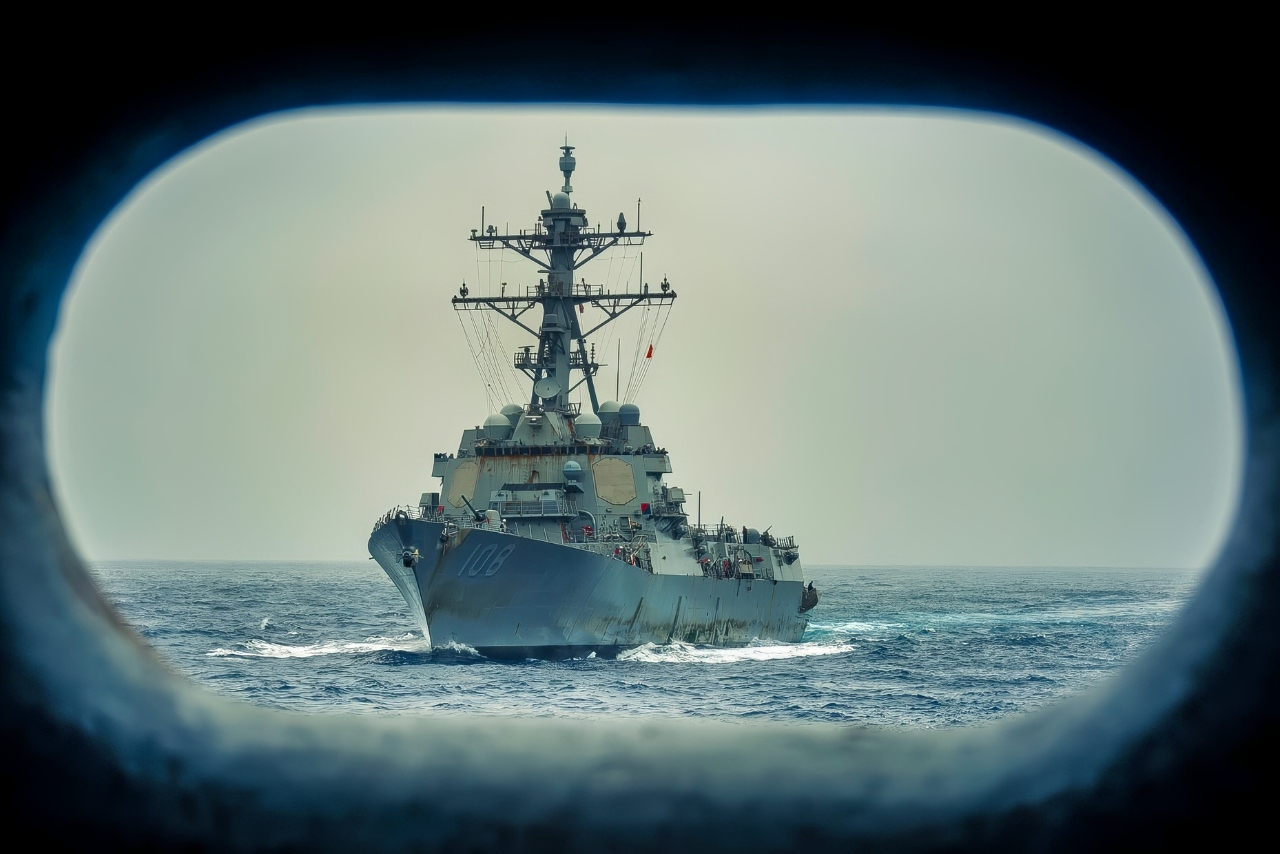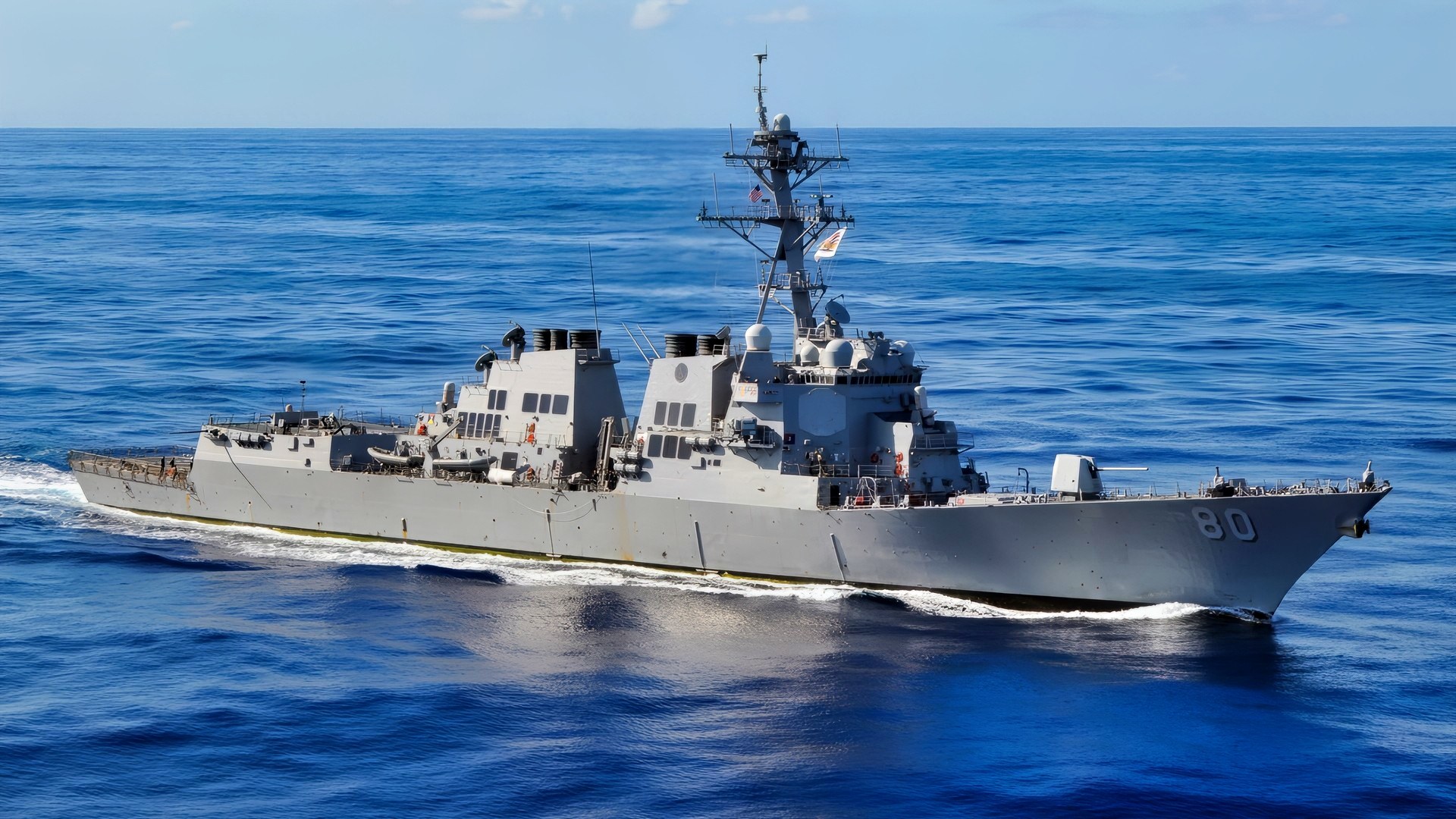Key Points and Summary – China’s 50,000–100,000 naval mines—spanning more than 30 types from basic contact to “smart” influence and remote-activated variants—are built for asymmetric A2/AD.
-Laid by subs, aircraft, and even civilian vessels, they can deny access, slow tempo, and raise risk across the Taiwan Strait and South China Sea at low cost.

(August 1, 2025) The Arleigh Burke-class guided-missile destroyer USS Wayne E. Meyer (DDG 108) approaches the Nimitz-class aircraft carrier USS Nimitz (CVN 68) for a replenishment-at-sea in the U.S. Central Command area of responsibility. (Official U.S. Navy photo)
-The U.S. Navy dominates blue water but remains underprepared for littoral mine warfare. Joint MCM demos with Japan help, yet gaps persist in scalable clearance, resilient logistics, and planning.
-Investing now in unmanned systems, ISR, and mine-focused concepts of operation is essential. In the next crisis, the first blast may come from the sea floor.
China’s Massive Naval Mine Arsenal Is a Threat
China’s large naval mine stockpile matters to the U.S. Navy. Asymmetric warfare and A2/AD are here to stay, and the vast majority of China’s 50,000-to-100,000-strong naval mine arsenal will be fielded to support those missions.
In a geopolitical competition or conflict, this weapons system will likely be used by the PLAN to deny U.S. forces freedom of movement or access in Western Pacific waters.
A Naval Mine Stockpile to Make You Sit Up and Pay Attention
China has one of the world’s largest naval mine stockpiles. With open-source estimates ranging from 50,000 to as high as 100,000, it is an arsenal built to support not just China’s asymmetric warfare capabilities, but also its anti-access/area denial (A2/AD) strategies.
That is a substantial quantity, made more imposing by its diversification into more than 30 types of mines, including contact, magnetic, acoustic, pressure-influence, and remotely-activated mines. These range from relatively simple, gravity-laid mines to much more sophisticated “smart” mines that can discern between hostile and friendly forces and receive remote activation commands.
The majority of China’s mines are meant for littoral use, particularly in the Taiwan Strait and South China Sea. Still, these assets pose a longer-term strategic threat to U.S. warfighting assumptions.

Zumwalt-class Guided Missile Destroyer USS Michael Monsoor (DDG 1001) transits the Pacific Ocean, June 25, 2022. Twenty-six nations, 38 ships, four submarines, more than 170 aircraft and 25,000 personnel are participating in RIMPAC from June 29 to Aug 4 in and around Hawaiian Islands and Southern California. The world’s largest international maritime exercise, RIMPAC provides a unique training opportunity while fostering and sustaining cooperative relationships among participants critical to ensuring the safety of sea lanes and security on the world’s oceans. RIMPAC 2022 is the 28th exercise in the series that began in 1971.
For example, the vast majority of China’s mines could be sown from Chinese submarines, aircraft, and even civilian boats (including those disguised as merchant ships) during a conflict, complicating their detection.
Beijing is also aware that the perception of potentially mined waters can deter, delay, or force the adversary to take a different route at far lower cost than missile or kinetic strikes.
Mine Warfare is a Key Part of China’s Force Build-up
China’s growing focus on mine warfare and its expanded stockpile have several key dimensions. First, it is simply a low-cost, high-payoff asymmetric option that can disproportionately tax adversary forces to clear away.
Second, mine warfare also nicely complements other elements of China’s A2/AD force posture, by combining geography, shallow water, and minefields that complicate an adversary’s entry, movement through, or exit from Chinese-controlled waters against surface ships.
Third, China is also rapidly developing its mine-countermeasure (MCM) capabilities, creating a race against time with the adversary.
In addition to the approximately 60 MCM ships it currently has, China has also recently been conducting joint experiments with what it calls “MCM anti-submarine warfare integrated operations,” in which experimental unmanned UUV swarms work with aerial detection platforms, hinting at the kind of increased automation and persistent surveillance of sea areas it is considering.

China UUV Drones. Image Credit: X Screenshot.
The U.S. Navy has also held recent joint demonstrations of mine-countermeasure capabilities with the Japan Maritime Self-Defense Force.
Still, more needs to be done to bring it up to the level required to ensure blue-water warfighting supremacy translates into effectiveness in the shallower, more confined, and more complex littorals.
Operational Implications for the U.S. Navy
The large Chinese mine stockpile has operational implications for the U.S. Navy. At the tactical level, it underwrites a potentially credible asymmetric threat against U.S. carrier strike groups, amphibious task forces, and supply lines in a high-end fight in contested seas.
Even though the U.S. Navy is dominant at blue-water combat operations, it is less prepared than it should be for mine-warfare challenges in littoral environments.
Joint demonstrations with Japan are helpful, but the reality is that mines are stealthy, cheap, and hard to detect before they detonate, even for high-tech navies. Minefields also degrade naval maneuverability by forcing deviations, slowing the tempo, and raising acceptable risk thresholds and tactical choices in ways that favor the defender.
The U.S. Navy is not without counter-options or the ability to fight this problem, but its current level of readiness is closer to vulnerable than dominant. It needs to address three structural weaknesses to shift this: scalable mine clearance and rapid disruption of minefields; resilient logistics and contingency planning for operations in heavily mined areas; and the integration of mine-threat analysis into pre-conflict operational planning rather than relegating it to an afterthought.
The larger strategic operating framework also needs to change to accept that mines are no longer relics of a past war, but rather modern weapons of denial and disruption.
The Navy’s force modernization efforts must make mine warfare a centerpiece of its distributed maritime operations, rather than a problem to be filed away under asymmetric or A2/AD-related concerns.
It must also rethink its operational approach to fighting through a mined environment rather than around it, using unmanned systems, adaptive route planning, and deception operations to keep the tempo and initiative.
Limits to the Mine-Threat Posture and Building on the U.S. Navy’s Existing Strengths
At the same time, the mine-threat posture does have its limits.
After all, the PLAN is up against the vastness of the seascape, the enormous logistical requirements of large-scale mine deployments, and the mines’ own reliance on shaping rather than decisive-force strikes.
For the U.S. Navy and its allies and partners, this means there are still mitigation options, such as increased ISR (intelligence, surveillance, and reconnaissance), unmanned systems, expanded MCM tasking, and operational maneuvers to avoid mined zones.
Indeed, the PLAN itself has publicly stated that far-sea MCM operations still have further development to go. In other words, the key point is that the U.S. Navy, and the Alliance it leads, must invest in these mitigation and countermeasures now. Waiting makes the problem exponentially worse.
China’s Large Naval Mine Stockpile Should Raise the Alarm Bells
China’s large naval mine stockpile is no trivia fact on a naval warfare Jeopardy game—it is an active lever that is already being pulled. The U.S. Navy must bring mine warfare out of the margins and into the mainstream of its force-structure and fleet-readiness calculus.
Failure to do so risks seeing key surface units, amphibious operations, and supply chains blindsided by what are, effectively, buried IEDs—silent, cheap, and with high potential for destruction. In the next Indo-Pacific crisis, the first explosion may not come from a missile or torpedo—it may come from a simple, unmarked mine.
Surface power without mine-warfare readiness is a brittle foundation.
The Navy must ensure that beneath its shiny hulls and high-tech sensors lies a fleet that can navigate, survive, and fight for sea control, even if the sea floor rises to hit back.
About the Author: Dr. Andrew Latham
Andrew Latham is a non-resident fellow at Defense Priorities and a professor of international relations and political theory at Macalester College in Saint Paul, MN. You can follow him on X: @aakatham. He writes a daily column for the National Security Journal.
More Military
Forget the F-35 of F-47: A 7th Generation Fighter Is Possible
$500 Drones are Destroying $10,000,000 NATO Tanks in Ukraine War
The Mach 2.2 F-4 Phantom II Fighter Has a Message for Every Air Force on Earth
China’s White Emperor ‘NGAD’ Stealth Fighter Summed Up in 2 Words











Shithole
October 28, 2025 at 8:14 pm
Biggest BS of our time.
Same type or in similar class as blinken’s outrageous claim that taiwan strait is now an ‘international’ waterway due to the dense traffic, and so US warships need to be around.
Hey, git off with this type of BS.
Shitpile
October 28, 2025 at 8:18 pm
These alleged mines are only useful for mining tokyo harbor and okinawa bays when sanae taikachi decides to go for some heroic military action, especially on the eve of annual yasukuni worshipping day.
Otherwise, otherwise, they’re comepletely useless.
bis-biss
October 28, 2025 at 9:25 pm
Trump is expected to meet with xi jinping on thursday (now still only tuesday evdning) in south korea, east asia, and this is the best chance ever for trump to arrest xi. Using SEAL commandos.
Xi has a lot to answer for. In a US Court.
The OPM hack during hussein obama’s that hauled upward of 20,000 names of american operatoves, the deadly august 2015 twin blasts in tianjin, the covid-19 pandemic, fentanyl smugglung, opioid crisis, the bribes to biden clan famuly and huge bribes to africa and asian politicians and the massive $350 million ‘contribution’ to american universities between 2022 to 2024 to purchase influence and control.
Xi needs to go to rikers island. ASAP.